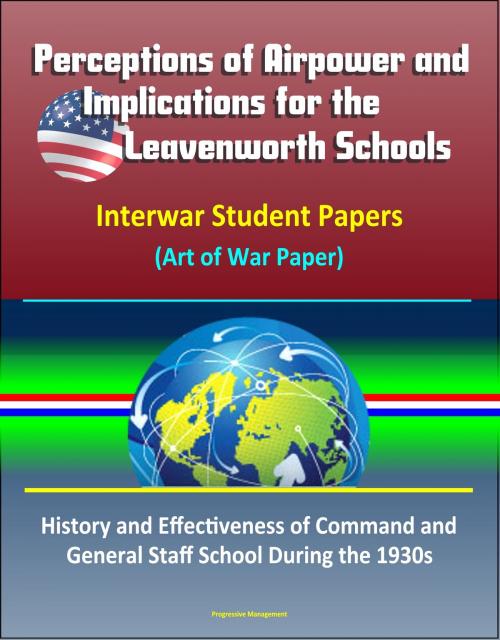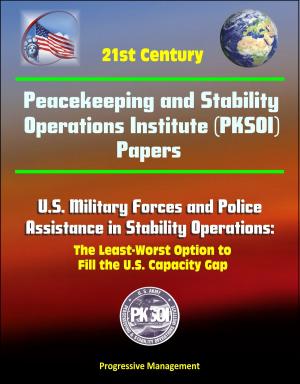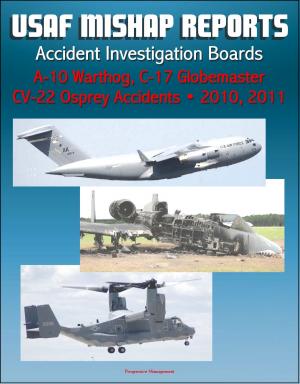Perceptions of Airpower and Implications for the Leavenworth Schools: Interwar Student Papers (Art of War Paper) – History and Effectiveness of Command and General Staff School During the 1930s
Nonfiction, History, Military, Aviation, World War I| Author: | Progressive Management | ISBN: | 9781370837472 |
| Publisher: | Progressive Management | Publication: | March 10, 2017 |
| Imprint: | Smashwords Edition | Language: | English |
| Author: | Progressive Management |
| ISBN: | 9781370837472 |
| Publisher: | Progressive Management |
| Publication: | March 10, 2017 |
| Imprint: | Smashwords Edition |
| Language: | English |
This excellent report has been professionally converted for accurate flowing-text e-book format reproduction. It evaluates interwar period US Army officer perceptions of aviation as expressed in student papers written as part of the Command and General Staff School during the 1930s. The evaluation compares student perceptions to period airpower theory and doctrine and applies that study to weigh-in on the broader debate over the effectiveness of Fort Leavenworth during the interwar period. America's School for War and Command Culture by Dr. Peter Schifferle and Dr. Jorg Muth, respectively, highlight the competing sides of that debate. Schifferle argues Leavenworth was a key component to the US victory in World War II while Muth argues the US victory occurred in spite of Leavenworth teaching faulty doctrine and stifling critical thinking.
This study concludes that the students generally agreed with period doctrine while also rejecting many of the ideas of airpower theorists. However, application of the study to the question of Leavenworth effectiveness yields mixed results. The papers indicate the doctrine, which formed the basis of Leavenworth instruction, was appropriate for the time. Nonetheless, they also suggest Leavenworth's willingness to part with critical thinking development (in the form of writing) in favor of more classroom instruction - instruction of debatable effectiveness.
As the United States Army slowly ramps down from more than a decade of continuous combat operations in Iraq, Afghanistan, and elsewhere, there are significant ongoing debates over the future of the Army. In an environment characterized by increasingly constrained resources, topics such as the size of the Army, the balance of capabilities between the active and reserve components, equipment procurement, and personnel costs predictably appear to dominate the discussion. That the Army must reduce in size because of these as other factors is, at this point, a foregone conclusion. However, the challenge is ensuring that those Army activities that remain through a post-war drawdown provide the best return on investment possible. In light of this challenge, it should not be a surprise that the topic of the best way to conduct Professional Military Education (PME) is a point of debate within the broader subject of the future of the US Army.
Given that the education and training of its personnel heavily influence the Army's ability to perform in future conflicts, the effectiveness of a portion of that system, the Command and General Staff School (CGSS) at Fort Leavenworth, has recently been the subject of increasing debate. In a blog at Foreign Policy online, Dr. Nicholas Murray leveled significant criticism against the conduct of the resident course at the CGSS. He noted that an emphasis on time spent in class, rather than quality of instruction and time for reflection, has become a focus of the CGSS curriculum. An earlier article by the same author stated the problem more bluntly, that "the current focus of PME does not adequately prepare our officers to think critically." Along similar lines, Jorg Muth argued that the current PME structure, including Leavenworth, fails to adequately educate Army officers to be effective staff officers. A recent article written by the former commander of the US Army Training and Doctrine Command, GEN Cone, who stated Leavenworth is not what it should be - an intellectual "Harvard on the Missouri," supports these assessments. However, what is particularly interesting in the debate over the effectiveness of Leavenworth in the Army's officer education system is not that it is happening, but that such debate is not new. Indeed, a number of works exist which explore the effectiveness of the instruction at Fort Leavenworth during the interwar period, points of which may be applicable to the current debate.
This excellent report has been professionally converted for accurate flowing-text e-book format reproduction. It evaluates interwar period US Army officer perceptions of aviation as expressed in student papers written as part of the Command and General Staff School during the 1930s. The evaluation compares student perceptions to period airpower theory and doctrine and applies that study to weigh-in on the broader debate over the effectiveness of Fort Leavenworth during the interwar period. America's School for War and Command Culture by Dr. Peter Schifferle and Dr. Jorg Muth, respectively, highlight the competing sides of that debate. Schifferle argues Leavenworth was a key component to the US victory in World War II while Muth argues the US victory occurred in spite of Leavenworth teaching faulty doctrine and stifling critical thinking.
This study concludes that the students generally agreed with period doctrine while also rejecting many of the ideas of airpower theorists. However, application of the study to the question of Leavenworth effectiveness yields mixed results. The papers indicate the doctrine, which formed the basis of Leavenworth instruction, was appropriate for the time. Nonetheless, they also suggest Leavenworth's willingness to part with critical thinking development (in the form of writing) in favor of more classroom instruction - instruction of debatable effectiveness.
As the United States Army slowly ramps down from more than a decade of continuous combat operations in Iraq, Afghanistan, and elsewhere, there are significant ongoing debates over the future of the Army. In an environment characterized by increasingly constrained resources, topics such as the size of the Army, the balance of capabilities between the active and reserve components, equipment procurement, and personnel costs predictably appear to dominate the discussion. That the Army must reduce in size because of these as other factors is, at this point, a foregone conclusion. However, the challenge is ensuring that those Army activities that remain through a post-war drawdown provide the best return on investment possible. In light of this challenge, it should not be a surprise that the topic of the best way to conduct Professional Military Education (PME) is a point of debate within the broader subject of the future of the US Army.
Given that the education and training of its personnel heavily influence the Army's ability to perform in future conflicts, the effectiveness of a portion of that system, the Command and General Staff School (CGSS) at Fort Leavenworth, has recently been the subject of increasing debate. In a blog at Foreign Policy online, Dr. Nicholas Murray leveled significant criticism against the conduct of the resident course at the CGSS. He noted that an emphasis on time spent in class, rather than quality of instruction and time for reflection, has become a focus of the CGSS curriculum. An earlier article by the same author stated the problem more bluntly, that "the current focus of PME does not adequately prepare our officers to think critically." Along similar lines, Jorg Muth argued that the current PME structure, including Leavenworth, fails to adequately educate Army officers to be effective staff officers. A recent article written by the former commander of the US Army Training and Doctrine Command, GEN Cone, who stated Leavenworth is not what it should be - an intellectual "Harvard on the Missouri," supports these assessments. However, what is particularly interesting in the debate over the effectiveness of Leavenworth in the Army's officer education system is not that it is happening, but that such debate is not new. Indeed, a number of works exist which explore the effectiveness of the instruction at Fort Leavenworth during the interwar period, points of which may be applicable to the current debate.















